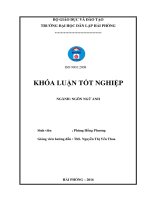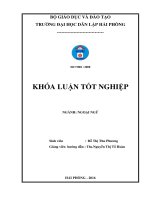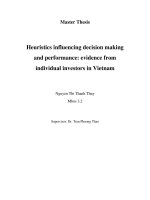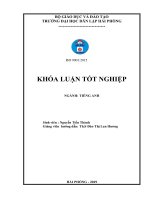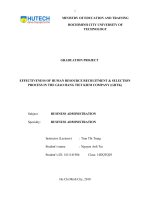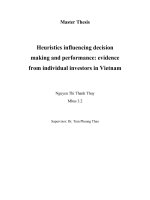Isolation of acidophilic and acid tolerant fungi from diverse environments in vietnam (khóa luận tốt nghiệp)
Bạn đang xem bản rút gọn của tài liệu. Xem và tải ngay bản đầy đủ của tài liệu tại đây (1.99 MB, 67 trang )
VIETNAM NATIONAL UNIVERSITY OF AGRICULTURE
FACULTY OF BIOTECHNOLOGY
THESIS
TITLE:
ISOLATION OF ACIDOPHILIC AND ACIDTOLERANT FUNGI FROM DIVERSE
ENVIRONMENTS IN VIETNAM
Student
: Nguyen Bao Ngoc
Faculty
: Biotechnology
Supervisors
: Nguyen Van Giang, Assoc. Prof. PhD.
Vu Nguyen Thanh, Assoc. Prof. PhD.
Hanoi, February 2021
COMMITMENT
I hereby declare that:
This is my study, which was conducted under the guidance of the supervisors;
All data provided are true and accurate;
All published data and information have been duly cited.
Hanoi, February 2021
Student
Nguyen Bao Ngoc
i
ACKNOWLEDGEMENTS
First of all, I would like to express my sincere gratitude to the Food Industries
Research Institute (FIRI), especially to the Center for Industrial Microbiology for
admitting and supporting me to conduct my thesis. Besides, special thanks have to be
given to the Department of Biotechnology, the Vietnam National University of
Agriculture for teaching me the useful knowledge and experience to conduct this
thesis.
Secondly, I am grateful to my supervisors Assoc. Prof., Nguyen Van Giang for
his priceless guidance and knowledge all the time.
I should also state my gratitude to my major Assoc. Prof., Dr. Vu Nguyen Thanh
for allowing me to conduct my project in FIRI and providing me with the logistic
support and his valuable suggestion to carry out my research successfully.
Above ground, I am indebted to my family for their love, caring, understanding,
supporting and sacrifices for educating and my future.
Thank you very much!
Nguyen Bao Ngoc
ii
TABLE OF CONTENTS
COMMITMENT ..............................................................................................................i
ACKNOWLEDGEMENTS ........................................................................................... ii
TABLE OF CONTENTS .............................................................................................. iii
LIST OF TABLES ..........................................................................................................v
LIST OF FIGURES ........................................................................................................vi
ABBREVIATIONS ........................................................................................................vi
ABSTRACT ................................................................................................................ viii
1.
INTRODUCTION .............................................................................................. 1
2.
LITERATURE REVIEW ...................................................................................3
2.1.
Introduction of acidophilic fungi ........................................................................3
2.1.1.
Origin and characteristics of acidophilic fungi ..................................................3
2.1.2.
Some representative group of acidophilic fungi Acidomyces acidophilus ........6
2.2.
Lignocellulose hydrolysis enzyme and enzyme from acid-tolerant fungi .......10
2.2.1 Lignocellulose hydrolysis enzyme .......................................................................10
2.2.2. Enzyme from acidophilic fungi ...........................................................................10
2.3.
Research on acidophilic fungi in the world and in Vietnam ............................ 13
2.3.1.
Research on acidophilic fungi in the world ......................................................13
2.3.2.
Research on acidophilic fungi in Vietnam .......................................................15
3.
MATERIALS AND METHODS .....................................................................16
3.1.
Materials ...........................................................................................................16
3.2.
Chemicals, equipment and machines ............................................................... 16
3.2.1.
Chemicals .........................................................................................................16
3.2.2.
Equipment.........................................................................................................17
3.2.3.
Media ................................................................................................................18
3.3.
Research methods ............................................................................................. 18
3.3.1.
Method of isolation........................................................................................... 18
3.3.2.
Purification and maintenance of strains ........................................................... 18
3.3.3.
Observation of colonies and cells .....................................................................19
3.3.4.
DNA extraction and purification method for mold cells..................................19
3.3.5.
Methods of PCR fingerprinting (Maheshwari, 2011) ......................................19
3.3.6.
Electrophoresis method ....................................................................................20
iii
3.3.7.
Staining the gel and read the result ..................................................................20
3.3.8.
Method to classify based on rDNA sequencing (Maheshwari, 2011)..............20
3.3.9.
Growth at different acid concentrations ........................................................... 21
3.3.10. Enzyme production and extraction (Maheshwari, 2011) .................................21
3.4.11. Determination Enzyme Activity Assays by agar diffusion method
(Maheshwari, 2011) .......................................................................................... 22
3.3.12. Protein electrophoresis by SDS-PAGE method and Zymogram method
SDS-PAGE method (Maheshwari, 2011) ........................................................ 23
4.
RESULTS AND DISCUSSION ......................................................................27
4.1.
Isolation results .................................................................................................27
4.2.
Observation of colonies and cells .....................................................................28
4.3.
PCR fingerprinting ........................................................................................... 30
4.4.
Classification of acidophilic fungi strains based on rDNA sequence
analysis .............................................................................................................33
4.5.
The growth of strains at different acid concentrations .....................................36
4.6.
Qualitative lignocellulose hydrolysis enzyme ..................................................38
4.6.1.
Determination of starch hydrolysis and cellulose degradation by disk
diffusion method ............................................................................................... 38
4.6.2.
Determination of protein, CMCase and xylanase ............................................40
5.
CONCLUSION AND PROPOSAL .................................................................43
5.1.
Conclusion ........................................................................................................43
5.2.
Proposal ............................................................................................................43
REFERENCES ..............................................................................................................44
ANNEX ......................................................................................................................... 47
iv
LIST OF TABLES
Table 2. 1. The list of the acidophilic fungi, the fungi originally described as
indigenous inhabitants of highly acidic habitats (pH < 3) (Hujslová et al.,
2019). ..................................................................................................................5
Table 2. 2. An overview of applications of acidophilic fungal enzymes in various
industries (Hassan et al., 2019). .......................................................................11
Table 3. 1. Experimental content ...................................................................................16
Table 4. 1. Classification of the collected samples .......................................................28
Table 4. 2. Groups of PCR fingerprinting .....................................................................32
Table 4. 3. The similarity between isolated strains and announced species .................33
Table 4. 4. The results of the CMC resolution .............................................................. 39
v
LIST OF FIGURES
Figure 2. 1. Extreme acidic environments. ......................................................................4
Figure 2. 2. Morphological features of the Acidomyces acidophilus WKC-1 ................6
Figure 2. 3. Acidothrixacidophila. ...................................................................................7
Figure 2. 4. Acidea extrema ............................................................................................ 8
Figure 2. 5. Microscopy of Hortaea acidophila, CBS 113389. Hyphae with
annellated zones, and conidia. Bar represents 10 µm. .......................................9
Figure 4. 1. Some places collecting the samples ........................................................... 27
Figure 4. 2. Some pictures of isolation on Malt-Glucose 2Bx 1% H2SO4 medium
agar plate ..........................................................................................................28
Figure 4. 3. Morphological characteristics of colonies and conidiophores on PDA
(left) and Malt 2Bx pH1 (right) of strains AS 565-2, AS 612-3, ASS 3589. Bar, 10 µm. ...................................................................................................29
Figure 4. 4. Electrophoresis images of PCR fingerprinting products of 67 strains.......31
Figure 4. 5. Phylogenetic tree on the basis of their sequences ......................................35
Figure 4. 6. The growth of strains on different acid concentration. .............................. 37
Figure 4. 7. Resolution ring showing CMC hydrolysis capacity ..................................40
Figure 4. 8. SDS-PAGE electrophoresis .......................................................................41
vi
ABBREVIATIONS
CMC
Carboxymethyl cellulose
DNA
Deoxyribonucleic Acid
dNTPs
Deoxyribonucleotide triphosphates
PCR
Polymerase Chain Reaction
PDA
Potato dextrose agar
SDSPAGE
Sodium
Dodecyl
Sulphate-Polyacrylamide
Gel Electrophoresis
TAE
Tris-acetate-EDTA
ITS
Internal transcribed spacer
vii
ABSTRACT
In the present work, we aimed to explore the biodiversity of acidophiles and
acid- tolerance, especially fungi isolated in Vietnam. Firstly, 103 different samples
were collected to isolate acidic strains to be able to grow in extremely acidic conditions
(pH 1.0). There are 109 strains were isolated and maintained before 20 representative
strains were sequenced. Strains belong to Acrodontium griseum, Aspergillus flavus,
Aspergillus terreus, Aspergillus turcosus, Penicillium chermesinum, Penicillium
citreonigrum, Penicillium georgiense, Talaromyces atroroseus, and Talaromyces
diversus have been identified. Two new species of Talaromyces and one new species
of Penicillium also were detected. By using untreated rice straw as the sole carbon
source, some lignocellulolytic activities of 20 representative strains were determined.
Xylanase, CMCase and amylase were detected through the disk diffusion method,
SDS-PAGE electrophoresis as well as zymogram electrophoresis. Most of strains
demonstrated strong CMCase, xylanase activities, meanwhile amylase activity was low.
viii
1. INTRODUCTION
All over the world, there are over 100,000 different species of fungi. They exist
at various extremes, including natural and man-made environments. Fungi able to
tolerate acidic conditions are frequently encountered in nature, and several species are
capable of growing at very low pH levels. There is no clear demarcation between
acidophilic and acidophilic fungi, but it is often assumed that acidophilic fungi are
those that can grow at pH 1.0 and have optimum growth at pH 3.0 or below.
In 1943, a strain of Acontium velatum and a “Fungus D” were shown to be
capable of growing in a glucose medium containing 1.25 M sulphuric acid at pH 0.
Unfortunately, the strain of Acontium velatum appears to have been lost since the initial
publication, but “Fungus D” is now believed to be a strain of Acidomyces acidophilus
which is commonly found in extremely acidic environments. According to Thanh et al
(2019), acidophility has been shown for only 6 fungal species, including Acidomyces
acidophilus (=Scytalidium acidophilum = Acidomyces
Acidomyces
richmondensis = Fungus
D),
acidothermus, Acidothrix acidophila, Acidea extrema, Acontium velatum
(no living specimen available) and Hortaea acidophila (=Neohortaea acidophila).
Phylogenetically, all acidophilic species are Ascomycota, and the teleomorphic state is
known only for Acidomyces acidothermus (described as Teratosphaeria acidotherma).
However, studies on acidophilic species have not been published much, and the range
of acidic tolarance in almost fungi remains a mystery.
Acidophilic fungi have received considerable attention, as their thermostable
enzymes can be employed in industrial processes at elevated temperatures. Increasing
the process temperature can have advantages, for example, increasing the rate of
chemical reactions, decreasing the viscosity of substrates and reducing the risk of
contamination by mesophilic microorganisms. For example, the strain Bispora sp.
MEY-1, well-known for the production of a range of thermophilic and acidophilic
lignocellulolytic enzymes.
1
To study the diversity of acidophilic and acid-tolerant fungi and investigate their
lignocellulose-degrading enzymes, we conduct the research entitled "Isolation of
acidophilic and acid-tolerant fungi from diverse environments in Vietnam".
Research objective
The objective of the research is to find out the acidophilic and acid-tolerant fungi
in Vietnam having technological potentials. More specifically:
• To isolate acidophilic fungi from various samples collected in Vietnam
• To determine the taxonomic positions of isolated acidophilic fungi
• To determine lignocellulolytic activity and properties of enzymes produced by
the obtained fungal strains
Requirement
• Sample collection
• Isolation, purification and maintenance of strains
• Examination of the growth of acidophilic strains at different acid
concentrations
• Classification
of strains by morphology, PCR fingerprinting, SDS-
PAGE electrophoresis
• Classification basing on rDNA sequencing
• Enzyme production and extraction for activity assays
2
2. LITERATURE REVIEW
2.1. Introduction of acidophilic fungi
2.1.1. Origin and characteristics of acidophilic fungi
Extreme environments usually possess various factors incompatible with most
life forms. Thus, certain environmental conditions such as low water availability in
hyperarid deserts or high temperatures seem to be close to the limit of biological activity
(Schulze- Makuch, Airo and Schirmack, 2017). However, despite the apparent hostility of
these extreme habitats, they contain a higher level of biodiversity than expected.
The number of different organisms known to reside and thrive in these
environmentally extreme conditions has grown rapidly in recent years. For example,
robust microbial communities at high-temperature ranges, i.e., the hot springs
acidophilic algae (Cyanidiaceae) grow at 45–56 °C (Skorupa et al., 2013), while the
hyperthermophilic archaea tolerate a temperature range above the boiling point (>100
°C) (Antranikian et al., 2017). Similarly, there are microbes living in very alkaline
environments (as high as pH
12) (Kambura et al., 2016). On the other end of the pH scale there are the
acidophilic archaea (i.e., Thermoplasma acidophilum) or the unicellular alga
Cyanidium caldarium thriving in very acidic habitats (pH ranges from 0–4).
Furthermore, they can survive exposure to such conditions for weeks, months, years,
or even centuries (Aguilera et al., 2007) .
Eukaryotic organisms are exceedingly adaptable, and they are present in all the
extreme environments reported until now. In this regard, acidophilic environments are
not an exception. Although it is usually assumed that high metal concentrations in
acidic habitats limit eukaryotic growth and diversity due to their toxicity, most of these
extreme environments showed an unexpectedly high degree of eukaryotic diversity.
Extreme acidic ecosystems usually include as well different abiotic extremes than low
pH (Rothschild and Mancinelli, 2001); (Tiquia-Arashiro and Rodrigues, 2016). Thus,
eukaryotes thriving at these habitats are often also exposed to low nutrient levels
(Brake and Hasiotis, 2010), high concentrations of toxic metals (Aguilera et al.,
2007), and/or extreme temperatures
3
(González-Toril et al., 2015). Additionally, several studies have revealed
representatives from multiple evolutionary eukaryotic lineages, suggesting that the
ability to adapt to pH extremes may be widespread (Zettler et al., 2002).
Figure 2. 1. Extreme acidic environments.
(a) Seltun acidic geothermal area, SW Iceland, (b) elemental sulfur forming from
gases venting the Soufriere Hills volcano on Montserrat, West Indies, (c) terraces formed by
iron precipitates in Río Tinto, SW Spain, (d) Río Tinto, SW Spain, at Salinas site (Aguilera
and González-Toril, 2019).
Acidophilic fungi have been reported from various acidic environments.
Hitherto, five fungal species isolated from acidic environments are known to be able to
grow in extremely acidic conditions. Acontium velatum Morgan was isolated from a
solution containing 4% copper sulfate (pH 0.2–0.7) (Starkey and Waksman, 1943).
Trichosporon cerebriae (an invalid name) was reported to grow in 2-N sulfuric acid
solution containing glucose and peptone (Sletten and Skinner, 1948). Capnodialean
anamorphic fungi were also isolated from acidic environments. Acidomyces
acidophilus was reported as an
4
acidophilic species and has been isolated from the soil (pH 1.4–3.5) adjacent to
a sulphur pilefield from a natural gas purification plant as Scytalidium acidophilum
(Sigler and Carmichael, 1974) and acid mine drainage (pH 0.8–1.38) as ‘Acidomyces
richmondensis’ (nom. inval.) (Baker et al., 2004). Hortaea acidophila Hoălker et al.
was also isolated from brown coal (pH 0.6) containing humic and fulvic acids (Hölker
et al., 2004). These latter two species were reported to be able to grow even at pH 1
(Sigler and Carmichael 1974; Baker et al. 2004; Hoălker et al. 2004; Selbmann et al.,
2008). Interestingly, these acidophilic fungi mentioned above are all anamorphic
fungi, and no teleomorphic species have been reported from such highly acidic
environments.
Table 2. 1. The list of the acidophilic fungi, the fungi originally described as indigenous
inhabitants of highly acidic habitats (pH < 3) (Hujslová et al., 2019).
Species
Acidea extrema
Acidiella bohemica
Acidiella uranophilac
Acidomyces acidophilus
Acidomyces
acidothermus
Acidothrix acidophila
Coniochaeta fodinicola
Neohortaea acidophila
Soosiella minima
Isolated
from
Highly acidic soil (Czech Republic)
Biofilm from the highly acidic river (Spain)
Highly acidic soil (Czech Republic)
Biofilm from the highly acidic river
(Spain) Abandoned mine (Japan)
Highly acidic oil shale by-products (Brazil)
Highly acidic water from uranium mine (Australia)
Highly acidic river water and sediment (Spain)d
Acidophilic algae, acid drainage (Germany)
Soil near sulfur pile (Canada) Sulfuric acid (Denmark) Volcanic soil
(Iceland)
Acidic industrial water (The Netherlands) Highly acidic soil (Czech
Republic)
Highly acidic hot springs (Japan)
Highly acidic water from uranium mine (Australia) Acidic waste
water of uranium mine (China) Highly acidic soil (Czech Republic,
Iceland) Acid mine drainage biofilm (USA) Acid transfer pipeline
(India)
Highly acidic soil (Czech Republic)
Enrichment culture of
archaeal
Richmond
mine
acidophilic Nanoorganisms from biofilms of mine (Germany)
Highly acidic water from uranium mine (Australia)
Acidic waste water from uranium mine (China) Highly acidic soil
(Czech Republic)
Extract of brown coal with humic and fulvic acids, pH 0.6
(Germany)
Highly acidic soil (Czech Republic)
5
2.1.2. Some representative group of acidophilic fungi Acidomyces acidophilus
Acidomyces acidophilus is a fungus first described by Sigler & J.W. Carmich
and again described by Selbmann, de Hoog & De Leo in 2008. Acidomyces
acidophilus is part of the genus Acidomyces and the family Teratosphaeriaceae, it is
also known as Scytalidium acidophilum, "Fungus D" or Trichosporon cerebriforme. It
contains melanin in cell walls that protect fungi from adverse environmental
conditions such as pH, temperature and extreme toxins. Anamorphic fungi,
hyphomycetes. Colonies growing slowly, faster in acidic medium, compact, dark.
Mycelium composed of septate, scarcely branched, brown and thick-walled hyphae,
eventually converting into a meristematic mycelium. Conidia produced by arthric
disarticulation of hyphae Figure 2.2 (Chan et al., 2019) .
Figure 2. 2. Morphological features of the Acidomyces acidophilus WKC-1
(a)colony of the isolated fungal strain in CDA medium, (b) Filamentous hyphae of the
strain with intercalary and unbranched hyphae with melanised and thick-walled cells and (c)
Hyphae terminal swelling cell using scanning electron microscope (SEM) at a magnification
of 1000× (b) and 2200× (c), scale bar in (b) and (c) 2 μm (Chan et al. 2018). Image
reproduced with permission of the rights holder, Springer
Acidothrix acidophila
Acidothrix acidophila is an acidic soil fungus. It belongs to the family
Amplistromataceae (Sordariomycetes, Ascomycota). The family Amplistromataceae
has been established for two genera, Amplistroma and Wallrothiella, of exclusively
wood- inhabiting fungi with similar morphological characteristics and acrodontium-
6
like asexual morphs (Huhndorf et al., 2009). Colonies on MEA (pH 5.5) at 24 °C, 21
days reaching a diameter of 76–77 mm; spreading, with abundant aerial mycelium
forming floccules and funicules, sporulation abundant, white to slightly salmon
(5YR8/2), reverse honey to ochre (5YR5/10). Colonies on acidic medium (MEA pH 2)
achieving diameters of 19–33 mm in 21 days at 24 °C; compact, centrally forming
funicules, with ruffled margin, powdery, coloured white, reverse cream to beige. On
PCA at 24 °C in 21 days colonies compact, centrally heaped with flat margin, without
aerial mycelium, yeast-like; reaching 15–20 mm in
diam. Conidiophores
semimacronematous consisting of a single phialide only, or macronematous consisting
of stipe bearing two to six phialides, sometimes in verticilate arrangement (prostrate).
Stipe 10–20 × 2.5–3.0 μm (Hujslová et al., 2014) .
Figure 2. 3. Acidothrixacidophila.
a,b - Colony on MEA pH5.5 at 24°C, 21days; c - Colony on MEA pH2 at 24°C,
21days; d
7
- Conidia globose,elipsoidalor lacrimose with hilum; e-h - Conidiophores and
conidia; i - Conidia proliferating by hyphae and bearing other conidia. Scale bars=10 μm
Acidea extrema
Acidea extrema is a fungus first described by Hujslová & M. Kolarík, isolated
from acidic soil (pH 2), belonging to the genus Acidea. Colonies on MEA (pH 5.5) at
24 °C, 21 days reaching a diameter of 17–36 mm, on acidic medium (MEA pH 2)
achieving diameters of 17.5–23 mm in 21 days at 24 °C. On both media colonies
compact, in some isolates with ruffled margin, centrally heaped to cerebriform,
wrinkled, funiculose or yeast-like, white to beige (10YR7/4), reverse honey to ochre
(7.5YR5/10). On PCA at 24 °C in 21 days colonies compact, centrally heaped with
flat margin, without aerial mycelium, yeast-like; 25 mm in diam. Mycelium sterile,
2.2– 0.5.5 μm wide, sparsely branched, fully filled with single line of granules, often
fragmenting. Sexual morph unknown (Hujslová et al., 2014).
Figure 2. 4. Acidea extrema
a - Colony on MEA pH2 at24°C, 21days; b - Colony on MEA pH5.5 at 24°C, 21days;
c,d,e - Sterile mycelium fully filled with granules; Soosiella minima. f - Colony on MEA pH
5.5 at 24
°C, 21 days; g, h - Sterile mycelium irregularly granular. Scale bars=10 μm
8
Hortaea acidophila
H. werneckii was accommodated in Hortaea. It is a hitherto black yeast was
isolated from an extract of brown coal containing humic and fulvic acids at pH 0.6.
Colonies on PDA at 25 °C attaining about 4 mm in 10 days, glistening, smooth, slimy,
jet black. Budding cells initially subhyaline, smooth, thin-walled, ellipsoidal, about 2.53.0 x 1.5-2.0 µm, later swelling, becoming darker and developing a central septum,
then broadly ellipsoidal, up to about 6 x 4 µm. Hyphae initially pale olivaceous, thinwalled, often starting with a series of ellipsoidal cells (toruose hyphae), later becoming
darker with thicker walls, pigmentation finally becoming somewhat irregular; hyphae
about 2.0-2.5 µm wide, cells about 12-20 µm long, occasionally subdivided in a later
stage. Local clumps of blackish-brown extracellular material are produced. Single
annellated zones inserted laterally on each intercalary cell, about 1.0-1.5 µm wide, very
short, annellations usually invisible with the light microscope. Conidia soon
developing into yeast cells (Hölker et al., 2004).
Figure 2. 5. Microscopy of Hortaea acidophila, CBS 113389. Hyphae with annellated
zones, and conidia. Bar represents 10 µm.
9
2.2. Lignocellulose hydrolysis enzyme and enzyme from acid-tolerant fungi
2.2.1 Lignocellulose hydrolysis enzyme
Lignocellulosic biomass consists of cellulose (32–50%), hemicellulose (19–
25%), and lignin (23–32%) polymers, as well as a small part of organic acids, salts,
and minerals (Pandey, Soccol and Mitchell, 2000); (Hamelinck, Van Hooijdonk and
Faaij, 2005). In nature, biomass-degrading microbes play a crucial role in plant biomass
decomposition and in nutrient cycling.
Lignocellulolytic enzymes are biocatalysts involved in the breakdown of lignin
and cellulosic materials into their components for further hydrolysis into useful
products. Sometimes referred to as lignocellulases, they include hydrolytic enzymes
that degrade
recalcitrant
show
lignocellulose,
a
component
of
plant
biomass.
Studies
that lignocellulolytic enzymes can be characterized as a large group of mainly
extracellular proteins, which include ligninolytic enzymes (peroxidases and oxidases)
and hydrolytic enzymes (cellulases, hemicellulases, pectinases, chitinases, amylases,
proteases, esterases, and mannanases). Enzymes are macromolecules produced by
living organisms that, when introduced into a reaction or system, can help accelerate
biological/biochemical reactions. They aid and spur on converting substrates into
useful end products as they give proper conditions for reactions to occur.
2.2.2. Enzyme from acidophilic fungi
There is an increasing demand for enzymes with high activity and stability at a
low pH range in order to expand the application of enzymes into extremely low pH
ranges. Since fungi generally grow well in the low pH range, they have attracted
attention as producers of such enzymes. However, there have been only a few reports
on the isolation of fungal strains that produce extremely acidophilic enzymes.
10
Table 2. 2. An overview of applications of acidophilic fungal enzymes in various
industries (Hassan et al., 2019).
Enzymes
Endopolygalacturonases
Exopolygalacturonases
Optimum pH
Optimu
m
Acidophilic fungal source
3.5
3.5
2.0-3.0
4
4.2
4.3
Temp
(ºC)
40
50
37
25
30
50
4
3.4-4.2
65
60
Paecilomyces variotii
Aspergillus niger
4
1.5-5.5
60
37
Aspergillus niger
Teratosphaeria acidotherma
AIU BGAe1
1.5
3.5
37
65
Bispora sp. MEYe1
Aspergillus niger
Penicillium sp. CGMCC 1669
Bispora sp. MEYe1
Aspergillus kawachii
Saccharomyces cerevisiae
Aspergillus niger
Aspergillus carbonarius
Applications
1. Clarification of
fruit, vegetable juices
and wines.
2. Animal feed
3. Paper and textile
industries
4. Treatment of pectic
waste water
5. Fermentation of
coffee and tea
6. Production of
baby foods
Xylana
ses
b-mannanases
4
4-4.5
3
4.0-5.0
4.0-5.0
1.5-2.0
2.4
4.0-6.0
3.5
3.5-5.0
4
4
2.6
2
30
40-60
70
40
22-55
37
62
65
20
55-75
50-60
50
65
45
2
50
2
4
3
3.5
4
1.5
4
2.4
50
80
70
70
70
60
40
50
Penicillium chrysogenum
Trametes hirsute Bm 2
Fomitella fraxinea
Trametes versicolor
Perenniporia tephropora
Hortaea acidophila
Sclerotium rolfsii
Phellinus ribis
Ganoderma lucidum
Penicillium citrinum HZN13
Penicillium oxalicum GZe2
Penicillium oxalicum GZe2
Bispora sp. MEYe1
Aureobasidium pullulans
Aureobasidium pullulans var.
Melanigenum
Penicillium sp. 40
Penicillium oxalicum GZe2
Bispora antennata
Aspergillus niger LWe1
Penicillium pinophilum C1
Phialophora sp. P13
Penicillium occitanis Pol6
Aspergillus sulphureus
11
1. Animal feed
2. Pulp and paper
3. Textile, food
industries
4. Agriculture
1. Paper and pulp
industries
2. Animal feed
3. Food and oil
drilling industries
Bispora sp. MEYe1 was found to synthesize novel acidic xylanases (Luo et al.,
2009). Furthermore, xylanase has been purified and characterized from the Penicillium
species, with optimum activity at pH 2.5. Four types of xylanases were produced by
Aureobasidium pullulans Ye2311e1, which shown maximum activity at pH 4.8 (Li et
al., 1993). Similarly, highly acidophilic extracellular xylanase with maximum activity
at pH 2 was found from A. pullulans var. melanigenum strain ATCC (20524) (Ohta et
al., 2001).
An example of a biotechnologically interesting enzyme that is potentially
available from Acidothrix acidophila is glucoamylase (3.2.1.3) participating in starch
degradation. A gene probably coding for glucoamylase has been found in the genome of
this fungus. Starch is one of the most important natural resources used in a variety of
industries. It is mainly used as a raw material in the production of glucose. The
production process involves two main enzymes, amylase and glucoamylase. Different
temperature and pH optima of these two enzymes lead to the necessity to adjust
different conditions in different production phases, which is highly costly. Therefore,
the glucoamylases from a variety of microorganisms including acidophilic fungi are
explored (Hua et al., 2014). A new highly thermostable glucoamylase with a broad pH
range stability and significant hydrolysis capacity has been revealed in Acidomyces
acidothermus (Hua et al. 2014). The acidophilic glucoamylase found in Acidothrix
acidophila represents a good target that might be tested to this purpose.
T. acidotherma AIU BGA-1 from an acidic hot spring is a new producer of
extremely acidophilic β-d-galactosidases. This strain grew well in the pH range 2.0–
4.0, and its growth rate slowed down at pH 5.0 and 6.0. The production of β-dgalactosidases was also highest by incubation at pH 3.0 and decreased by shifting the
initial pH to 5.0–
6.0. These results are in agreement with capable of growing well under
extremely acidic conditions at high temperature were cultivated with a liquid medium
with an initial pH of 3.0, the final pH of the culture broth varied widely between 2.5
and 9.0, and enzymes with high activity and stability at the low pH range were
obtained in the strains maintained at pH below 6.0 (. Thus, the isolation of fungal
12
strains that grow well under extremely low pH and high-temperature conditions was
effective to obtain extremely acidophilic enzymes (Isobe and Yamada, 2019).
So far, very limited studies, related to the characterization of acidophilic fungi
and their production of acid-tolerant enzymes and applications as biocatalysts in
various unusual industrial processes, have been carried out. Industries are looking for
alternatives to chemically mediated processes because of alertness toward the
protection of environments and the necessity of sustainable biofuel substitutes, and one
such alternative is enzymes catalyzed processes. The enzymes of acidophilic fungi are
known for their abilities to work efficiently in extreme conditions of some important
industrial processes.
These acidophilic fungi are the main source of acid-stable enzymes that could
be utilized in many industries including paper, leather making, food and feed industries,
where the efficacy of commonly available enzymes is limited by challenges. Most
importantly, these enzymes are efficient, environmentally friendly and represent the
foundation for sustainable industrial technologies. Besides, fungi from extreme
environments, they can serve as a source of enzymes and metabolites with potentially
uncommon properties.
2.3. Research on acidophilic fungi in the world and in Vietnam
2.3.1. Research on acidophilic fungi in the world
Interest in discovering extreme environments and the organisms that inhabit
them has grown over the past years due to both basic research, and applied aspects,
i.e., extremophiles as the sources of enzymes and other cell products. The
biotechnological potential of extremophiles and their cellular products is now a major
impetus driving research. The fields of biotechnology that could benefit from mining
the extremophiles are numerous and include the search for new bioactive compounds
for industrial, agricultural, environmental, and pharmaceutical uses (Tiquia and
Mormile, 2010), (Tiquia-Arashiro and Rodrigues, 2016); (Krueger et al., 2018). An
example, the remarkable tolerance of A. acidophilus to adverse conditions and its
significant variability and ability to mediate in extreme acidity ecosystems where most
forms of life may open up research opportunities and exploration for planetary and
13
astrobiological studies in the search of life on acidic and hot planets such as our sister
planet, Venus (Chan et al., 2019).
Although A. acidophilus has proven to be effective in removing metalloids such
as arsenic in soil in laboratory settings, in order to apply it to remediate contaminated
soil effectively it needs to be scaled up accordingly. Recent advances in molecular
biology and biotechnology techniques can be applied to genetic modify A. acidophilus
to improve its remediation capabilities. The genes involved in the detoxification of
heavy metals in A.acidophilus can be cloned and expressed in a fast-growing host.
Various genetic engineering approaches have been developed to optimise
mycoremediation by engineer- improved fungi and enzymes. A. acidophilus contains
several genes that encode glutathione S-transferase and through genetic splicing or
gene regulations, these important genes that reduce the toxicity of arsenic from
arsenate to arsenite can be overexpressed or used to construct new metabolic pathways
in other fungi, allowing the novel enzymes/genes that are produced by A. acidophilus
to be used to remediate not only metals but also other pollutants (Chan et al., 2019).
Knowledge of the phylogenetic and physiological diversities of acidophilic
microorganisms has expanded greatly in the past 25 years. Data from biomolecular
studies of extremely acidic sites, however, suggest that a large number of
extremophilic fungi in general and particularly acidophilic ones still await isolation
and characterization. There is a great deal of interest in acidophiles, not only from the
standpoint of understanding how these microorganisms can thrive in conditions that
are hostile to most life forms but also due to their importance in environmental
pollution and in biotechnology. To date little is known regarding the role of
acidophilic fungi in shaping the varied ecosystems that occur in acidic environments
and less about whether these microorganisms can support microenvironmental
conditions that increase the survival of other members of the microbial community, or
the interaction between different organisms enhances colonization of others.
Acidophilic fungi have to play an even more important role in the development of
microbial communities in extreme environments by providing a suitable architectural
structure, mechanical stability, and protection against external conditions and be able
14
to selectively accumulate metals from the surrounding water (Aguilera and GonzálezToril, 2019).
2.3.2. Research on acidophilic fungi in Vietnam
In recent years, scientists have paid special attention to the strains of fungi that
can survive and thrive in harsh environmental conditions. in which, international and
domestic studies related to refractory fungi have been studied a lot in recent years
(Maheshwari, Bharadwaj and Bhat, 2000). However, regarding the fungus that is
resistant to strong acids,there is still no specific study in Vietnam. Special attention is
paid to the biodiversity and properties related to the enzyme-generating ability of
strains. Aside from the recently emerging heat-resistant fungi enzyme as a promising
alternative in biotechnology applications, the acid-resistant fungi enzyme is still a
relatively new problem. Scientists around the world have been going deeper into this
group of potential fungi, but currently there is no scientific work in in-depth research in
this field. In Vietnam, although agriculture is the foundation for development, the
problem of research and application of science in production is still very limited. With
the advantage of being a tropical country, it can be said that it is not too difficult for us
to find the fungus strains with precious properties and do in-depth studies, with longterm possible applications. industry, agriculture and life (Thanh et al., 2019).
15
3. MATERIALS AND METHODS
3.1. Materials
In total, 103 samples including 37 plant samples, 40 soil samples, 21 fruit samples
and 5 flower samples collected from different areas in Vietnam such as Hanoi, Thai
Nguyen, Hung Yen, Bac Giang, Thai Binh, Son La, Hai Duong. From there, 109 strains of
acid-tolerant and acidophillic fungus were isolated and used as the research object.
Table 3. 1. Experimental content
Time
7/2019-11/2019
Place
Content
Vietnam
Sample collection
Isolation, purification and maintenance of
strains
Classification of strains by morphology
The
for and PCR fingerprinting
Center
Identification
Industrial
11/2019-02/2020 Microbiology,
Industries
of
strains
by
DNA
Food sequencing
Research Enzyme Activity Assays
Institute
Test for growth of strains on other different
acid concentration medium
Protein electrophoresis by SDS-PAGE and
Zymogram
3.2. Chemicals, equipment and machines
3.2.1. Chemicals
Chemicals used in culture and fermentation media:
D-Glucose (China); Agar (Vietnam); KH2PO4 (China); (NH4) 2SO4 (China);
CaCl2 (China); MgSO4.7H2O (China); peptone; yeast extract; 1000X minerals.
The mineral composition includes:
FeSO4.7H2O (China); MnSO4.H2O (China); ZnSO4.7H2O (China); CuCl2.6H2O
(China)
16
